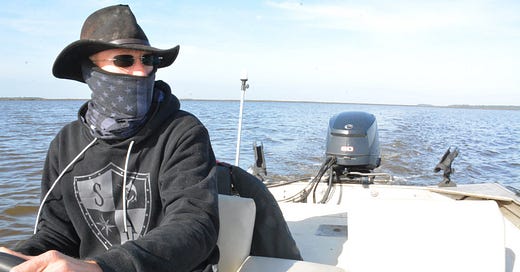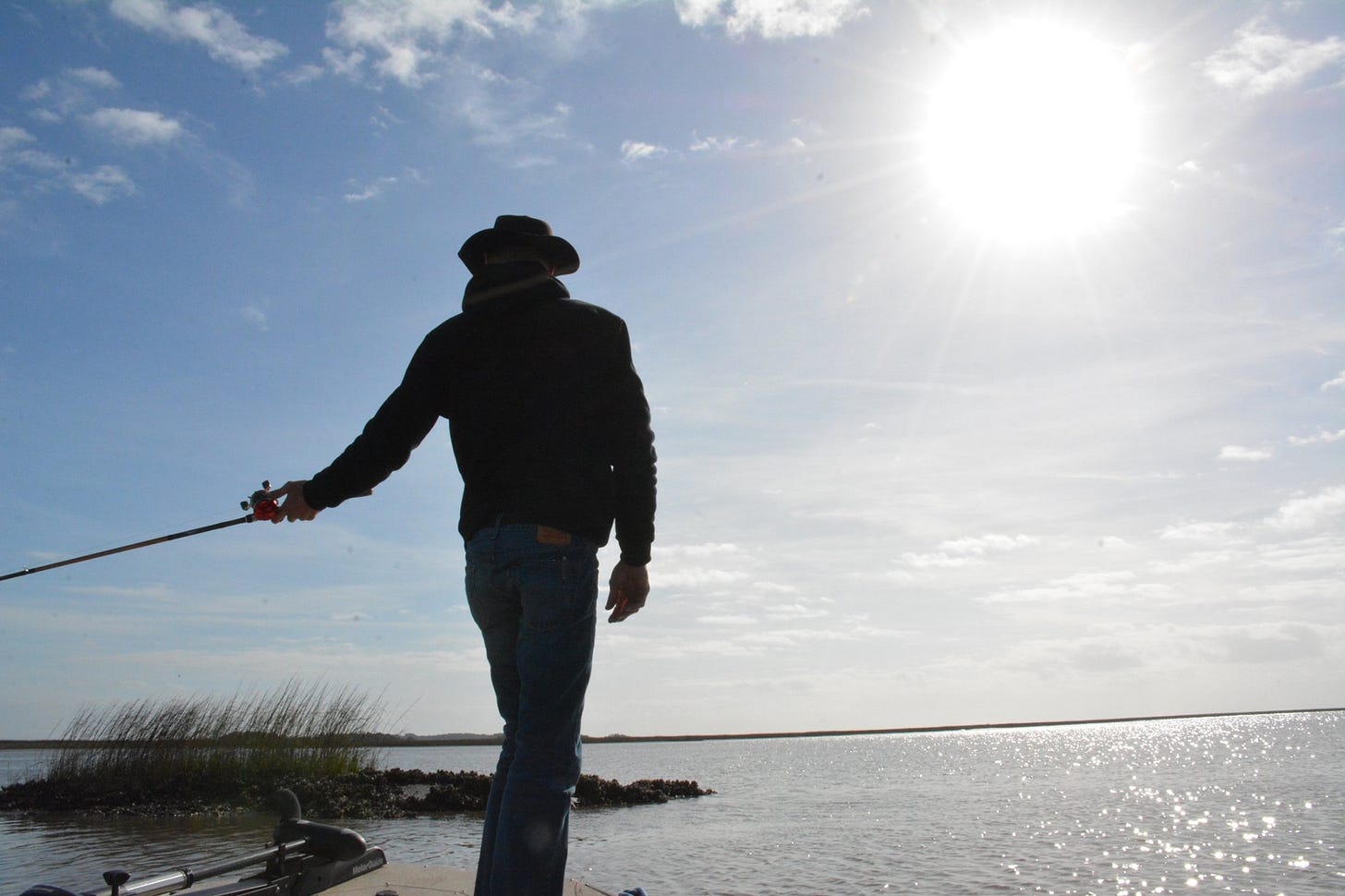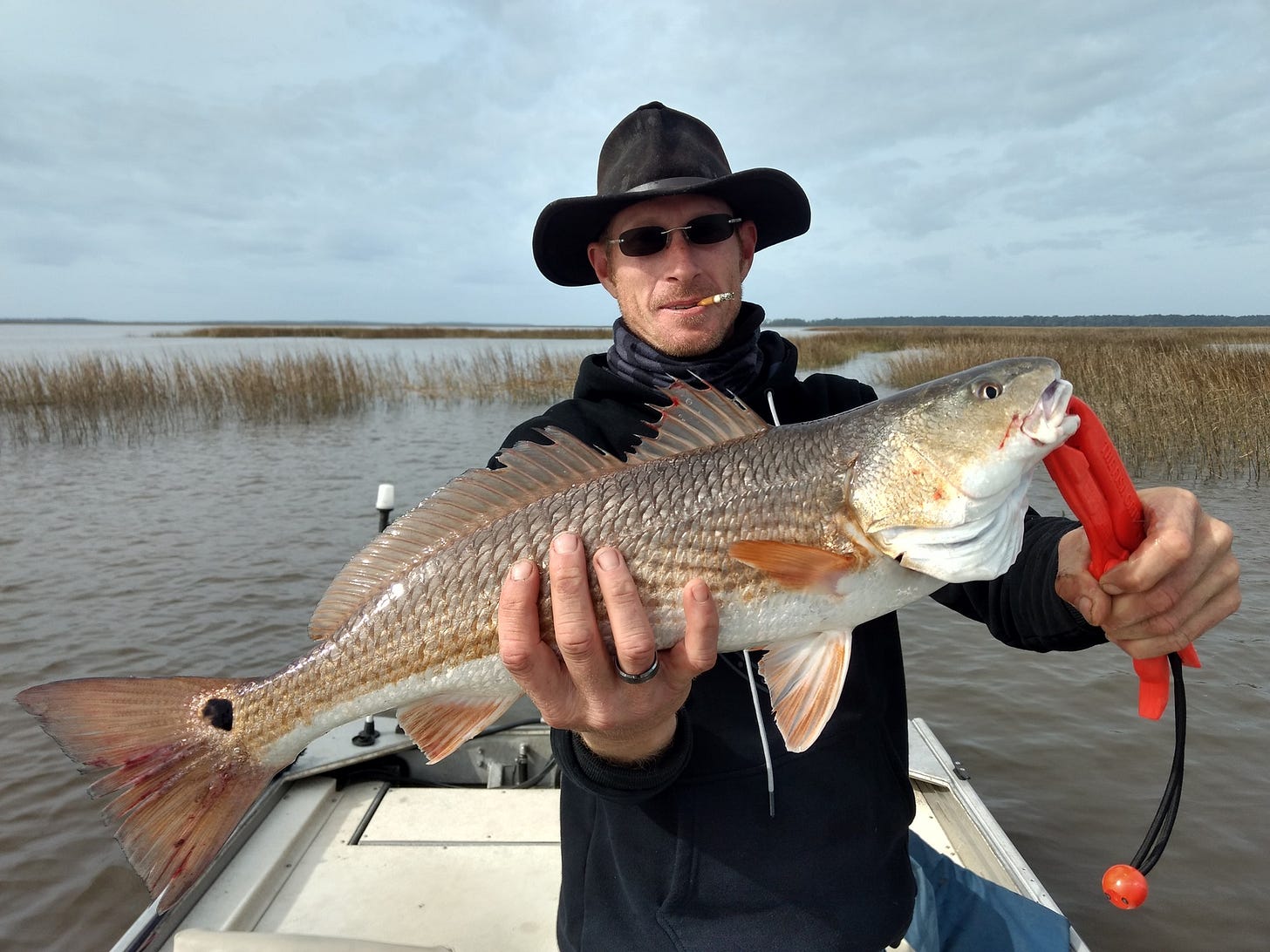Dawn is only minutes away, and yet we wait. We dare not ride.
The light teases us off east toward Beaufort, land of The Prince of Tides, and the Evinrude idles, puttering us forward with a lazy chop through a mist of salt and cold.
“You can’t see it, but there is an oyster bed right over there,” Bones said, his face obscured by tenacious, clinging darkness and a skull-and-crossbones gaiter. “And that’s a sand bar right in front of us. You don’t run full throttle here if you don’t know this river. We’ll wait for the sun.”
The weather man said the rain and wind would clear off at daybreak. The weather man lied.
The channel widened, and then rowdy waves rose up as if to greet the soon-risen sun. My pilot made sure to keep the bow into the waves and not broadside.
And then the water got rough.
“If a wave comes over the side, use your hat or shirt and get out as much as you can as quick as you can,” Bones warned. “Because there’s another wave coming.”
Was he joking with me?
You ain’t back home in Grand Dad’s freshwater bluegill bream pond anymore, old boy, that’s for sure.
You don’t just float on a saltwater river – the river envelops you as its own. The mist coated my skin and speckled my glasses, the pungent smell filled my nostrils; I could smell every fish, every oyster, every ray or dolphin, with a healthy mix of salt mudflat for extra flavor. I asked Bones how he would describe that smell if he were writing about it.
“Home,” he said.
Then the sun decided that it had teased us long enough and reluctantly slipped a toe out of bed, the edge of the world lit the heavens just enough for two South Carolina boys to avoid danger, and it was time to cross the Coosawhatchie.
“Turn your hat around and hang on.” The throttle was shoved forward, the bow lifted, the motor gunned and we were planed out atop tide and current and adrenaline, speeding and bouncing toward a hot date with what I fear might just become my new main squeeze – the beautiful redfish.
The heart of a fighter
We found them. Redfish, speckled trout and even a flounder, up to the same mischief we were – looking for a fish dinner. But while the redfish lurked about the oyster beds, mud flats and spartina marsh islands in search of an easy meal, we were hoping to fight for ours.
And fight we did.
Berkeley rods and Abu Garcia reels. 50 lb. braided line with a 30 lb. mono leader. We bounced Electric Chickens and Vudu Shrimp and big spinner baits off the oyster rakes, or dragged them carefully through the flooded, grassy flats.
We tried to cover ground because the clock was ticking. Unlike my favorite bass ponds, here life changes every six hours with the tide, then changes again. All creatures here, above and below, live by it, running on an unstoppable schedule as old as the earth and the moon itself. Our targets hunted with the current and the tide, ganging around the islands and shorelines where the bait fish were hiding, waiting patiently for the escaping tide to flush them back out into the open, all the while keeping a wary eye out for predators like the bottlenose dolphin.
Welcome back to the real word, little fellows, Big Red must think. We’ve only got a few hours. Let’s eat.
Bull reds are 27 inches and greater and the largest red on record topped 94 pounds. These amazing fish can live up to 40 years. I wish I could say that my first redfish was a coveted bull but that would be a fish tale. Oh, I hooked him all right. For a moment, I was the one doing the fishing. The bull struck, and then he was in charge. He had me. This was no farm pond largemouth. This fish was a gangster. No one ever fed this guy floating catfish food – this fellow worked for a living.
It was like trying to snatch a cinder block from the sticky bottom – until it decided to run.
“Don’t do it!” Bones yelled. “Don’t do it!”
I caught one glimpse of him at the surface: a monster. But it was too late. I had let the bull take the line where he wanted it, somewhere up Savannah way, and even the stout braid was no match for his prowess, as the tight line touched the stern and we parted ways, with some hurt feelings and some salty barbs from my so-called fishing buddy.
“I put you on the fish,” Bones mocked. “I practically put the fish on the hook for you. And you still let him get away.”
“What are you, The Redfish Whisperer?” I retorted.
Bones thought about that for a minute. “You don’t quite get it. You will soon, though.”
One channel downstream and my first official red was a modest guy, but he fought like two bass. I reached for lips as I boated him.
“Don’t do that!” Bones said. “These bad boys eat crabs and pretty much anything they want. Stick that finger in his mouth and you’ve had a bad day.”
Advice taken, I boated another. And then another. All legal keepers. All perfect eating size.
Redemption. It was a beautiful thing. But inside, something was happening to me.
Getting to know an old friend
The Coosawhatchie River region was home to the Coosaw, or Coosa, Native Americans who roamed between Charleston and Savannah. They lived among the Yamasee, the Combahee and the Edisto, hunting, fishing and trading, until they were almost completely wiped out or scattered by around 1750, leaving behind only artifacts and place names.
The King’s Highway ran through here, and Gen. Robert E. Lee made Coosawhatchie his headquarters during the early years of the Civil War. Lee’s troops dug massive earthworks along her banks to stop Federal gunboats from steaming north.
Seven creeks converge to give life to the Coosawhatchie. It is born dirt-humble from ditch drippings in poor, rural Allendale County, but gains girth and respectability as it gains salinity. The Coosawhatchie flows southeast for 50 miles, through four Lowcountry counties, transforming itself to brackish and then into a salty, tidal force of nature near Highway 17. It merges with the Pocotaligo River to form the Broad River, then joins forces with the Chechesee and the Beaufort rivers to form the Port Royal Sound and empty into the mighty Atlantic.
But I knew none of that as a child, nor would I have cared, because to me the most important stretch of the Coosawhatchie meandered modestly along the Back 40 of my grandfather’s farm. “The Swamp,” as we called it, was the setting for most of my childhood. We grew up hunting deer and squirrel along its banks, plying its waters in canoes and aluminum War Eagles for red breasts, jack fish and swamp cats, dropping a trap in the spring for the crawdads. In dry years, we would wade across her and search for arrowheads, or slip loose the coon dogs.
The river Coosawhatchie has long been a friend of mine, but as is too often the case, sometimes we don’t really, truly know our friends. I knew her as a gentle, freshwater childhood companion, having never tasted the sweet saltiness as she matured downstream. Now that I have, I love her even more.
Making a new friend
Sciaenops ocellatus. With his reddish-bronze color and tell-tale black tail spot, he has more names than Carter’s has Little Liver Pills: redfish, red drum, spottail bass, puppy drum and channel bass. Big Red ranges from New England to northern Mexico, his hangouts range from beach front property to tidal creeks and rivers, and he is easily the most popular inshore species in the Southeast. Redfish have a firm, moderate flavor and are not oily – a diner’s dream.
But sometimes the winner of a popularity contest can lose big. In the 1970s and 80s, a Cajun food craze swept the nation and restaurants couldn’t get enough blackened redfish. Commercial fishing for reds, using gill nets and purse seines, exploded to satisfy diners from New Orleans to New York, and after years of severe overfishing the fish became imperiled.
Outdoor writers have called it “The Redfish Wars.” Concerned recreational anglers banded together to form the Gulf Coast Conservation Association (now the Coastal Conservation Association) and states like Texas and Florida passed laws protecting the red drum. My home state of South Carolina began protecting the species in 1986. Commercial fishing for reds was banned in federal waters, and in 2007, Pres. George W. Bush issued an Executive Order designating the redfish as a protected game fish. Today a S.C. angler can only keep two redfish per day, 15-23 inches only, and only six per boat.
The redfish is lucky to be here today in such numbers, and we are lucky to have it. Because of this conservation success story, novice saltwater fisherman like I have come to love and respect this marvel of a fish, and one day my kids can appreciate and enjoy him.
The redfish: a fighting beauty that tastes great and lives 25 minutes from my driveway. Where have you been all my life? After the saltwater was rinsed off boat and trailer, and the gear stowed away, Bones and I enjoyed a Scotch and grilled redfish on the halfshell over glowing oak and pecan coals. Leave the scales on the filet, brush the grill with olive oil, season with only sea salt or Lawry’s seasoned salt, coarse ground black pepper and garlic powder, and scrape the filet off the skin when it’s done. You’ll fall in love and catch yourself writing love sonnets to a fish on the back of your napkin, I promise.
Lying in bed that night, my stomach and memory banks full of redfish, I finally got it. I understood what Bones had been saying. No matter how good you are, you don’t whisper to the fish. That sound, pulling you back in with the ebbing tide?
That’s the redfish whispering to you.
Author’s Note: This story was originally published in Sporting Classics magazine. Pictured is Tee Murdaugh, the “Redfish Whisperer” of Hampton County, S.C.







Loved this !